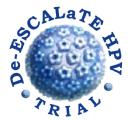Trial Summary
| Title: |
De-ESCALaTE HPV: Determination of Epidermal growth factor receptor-inhibitor (cetuximab) versus Standard Chemotherapy (cisplatin) early And Late Toxicity Events in Human Papillomavirus-positive oropharyngeal squamous cell carcinoma |
|
Rationale: |
Oropharyngeal squamous cell carcinoma (OPSCC) incidence is increasing rapidly in the developed world. This has been attributed to a rise in Human Papillomavirus (HPV) infection. HPV+OPSCC is considered a distinct disease entity, affecting younger patients and has a good prognosis following treatment. Subsequently, patients can live with the considerable side effects for several decades. Radiotherapy and cetuximab (Epidermal Growth Factor Receptor-inhibitor) have demonstrated similar efficacy to ‘platin’ chemoradiotherapy (current standard treatment containing platinum-based compounds) in head and neck cancer, but is potentially less toxic. Results of this trial will be used to determine the optimum treatment of this debilitating cancer, with the primary aim of decreasing toxicity and improving quality of life for HPV+OPSCC patients. |
|
Eligibility Criteria: |
|
|
Exclusion Criteria: |
|
|
Objectives: |
For HPV+OPSCC compared to current standard treatment will cetuximab + radiotherapy result in: 1. Less morbidity (acute and late toxicity)? 2. Better quality of life? 3. Better cost effectiveness? 4. Any significant differences of overall survival and locoregional recurrence between the two arms? |
|
Trial Design: |
Pragmatic, randomised, international, multi-centre, open label, phase III clinical trial determining the optimum treatment for patients with HPV+OPSCC. |
|
Treatment: |
Cetuximab: IV 400mg/m2 dose 1 week before start of radiotherapy followed by a weekly IV infusion of 250mg/m2 X 7 during radiotherapy Cisplatin: 3 doses of 100mg/m2 given at days 1, 22 and 43 from start of radiotherapy |
|
No. patients: |
304 |
|
Sample Collection: |
40mls bloods at baseline, 3 months & 12 months post treatment end. Also, at recurrence or progression for relevant patients. Oral fluid at baseline, 3 months & 12 months post treatment end. Also, at recurrence or progression for relevant patients. FFPE blocks of diagnostic biopsy specimens and, if applicable, post treatment biopsies and when neck dissection has been performed and biopsies at recurrence or progression. A subset of patients will have fresh frozen samples collected. |
|
Stratification: |
|
|
Outcome measures: |
Primary: Severe (acute and late) toxicity (Grade 3-5), assessed by CTCAE version 4 Secondary: Acute severe toxicity Late severe toxicity Quality of Life (QoL) – assessed by EORTC QLQ C30 and HN35 Dysphagia – assessed by MDADI and by PEG utilisation rate at 1 and 2 years Cost effectiveness – assessed by EuroQoL-5D Overall survival, recurrence and metastasis |
|
Analysis:
|
Analyses will be performed on the intention to treat population. Comparison of numbers of late and acute events will be by a Poisson model; comparison of proportion of patients affected by toxicity by Pearson’s chi-squared. A sensitivity analysis will be carried out using the TAME method of reporting toxicities. Overall survival will be compared using the log-rank test. There will be additional analysis of the IMRT and conformal RT subgroups and toxicity of those receiving induction versus those who did not. Analysis of all other secondary endpoints will be carried out using appropriate tests. |

